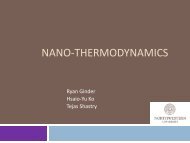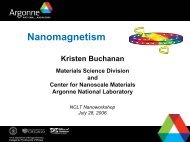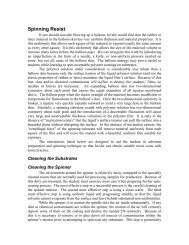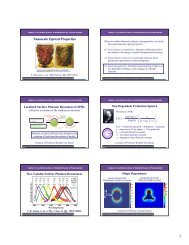A Practical Guide to SPM
A Practical Guide to SPM
A Practical Guide to SPM
Create successful ePaper yourself
Turn your PDF publications into a flip-book with our unique Google optimized e-Paper software.
29<br />
In TappingMode, when operating on the high-frequency side of the<br />
resonance peak (Figure 10-6), rings may appear around raised<br />
features that make them look like they are “surrounded by water,” as<br />
in the image of Ti grains on the left. Decreasing the drive frequency<br />
during imaging can eliminate this artifact, as shown in the image on<br />
the right. (When reducing the drive frequency, the setpoint voltage<br />
may need <strong>to</strong> be reduced, <strong>to</strong>o.)<br />
Figure 10-6. Rings during high-frequency operation.<br />
The arch-shaped bow in the scanner becomes visible at large scan<br />
sizes (Figure 10-7, left). The bow in this image can be removed by<br />
performing a second order planefit in X and Y (Figure 10-7, right).<br />
At large scan sizes, the bow in the scanner may take on an S-shaped<br />
appearance (Figure 10-8, left). The bow in this image can be removed<br />
by performing a third order planefit in X and Y (Figure 10-8, right).<br />
Figure 10-7. Large scan size, second order bow.<br />
Data scale = 30nm.<br />
Figure 10-8. Large scan size, third order bow.<br />
Data scale = 324nm.
















